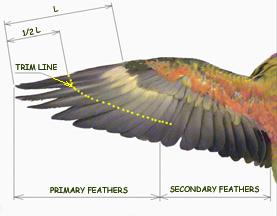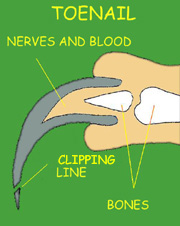

The feathers
Birds are flying creatures. Wings are meant to let them go from place to place. Trimming a bird's wings is a form of mutilation, it takes from him his essence. Ideally the wings should never be trimmeded. The only acceptable justification is the security of the parrot.
It is important to understand the function of the feathers in the wings and the way they grow before deciding to clip them. In the wings and the tail, feathers never fall all at the same time, otherwise the bird would be handicapped until they grow back. These feathers fall out one at a time. Before the new feather is fully grown, it stays very fragile for a certain time and the adjacent old feathers keep the new one from breaking.
The new, partially grown, feather's shaft is full of blood. If by accident it brakes, the bird might bleed to death, losing his blood through the shaft which acts as an open vein. The broken blood feather must be immediately removed to avoid death.
If the primary feathers are trimmed too short, there is nothing to protect the new growing feathers which are left exposed and vulnerable to accidents. There are no long, old feathers to support the new ones. Often these new feathers break repeatedly before they grow to their full length. The situation is such that the bird stays handicapped forever, prone to accidents of all sorts because it is unable to grow new, full flying feathers.
If the wings must be trimmed, it should be done in such a way that the bird will be unable to fly high up, only horizontally. All the primary feathers will be trimmeded at a minimum length sufficient to keep the bird at a reasonable flying ability. The secondary feathers are never to be touched; they give the bird the possibility to control its landing. In most cases trimming half the exposed length of the primaries will give the desired results.
such a way that the bird will be unable to fly high up, only horizontally. All the primary feathers will be trimmeded at a minimum length sufficient to keep the bird at a reasonable flying ability. The secondary feathers are never to be touched; they give the bird the possibility to control its landing. In most cases trimming half the exposed length of the primaries will give the desired results.
The toenails
They serve a very important purpose in the bird's ability to climb, 1 to keep its food and to hold on branches. They should be clipped only when they are overgrown. It is enough to clip 1 or 2 millimeters of the nail, never more. Clipped too short, the toenails may grow too quickly making the need of clippings more often. Also, the tips never grow properly, become too rounded and the bird is unable to use them for what they are needed. The abrasive concrete perches one can buy in the pet stores are excellent to simply make the tips of the
toenails less sharp and the clippings are no longer necessary.
to keep its food and to hold on branches. They should be clipped only when they are overgrown. It is enough to clip 1 or 2 millimeters of the nail, never more. Clipped too short, the toenails may grow too quickly making the need of clippings more often. Also, the tips never grow properly, become too rounded and the bird is unable to use them for what they are needed. The abrasive concrete perches one can buy in the pet stores are excellent to simply make the tips of the
toenails less sharp and the clippings are no longer necessary.
The beak
The beak should never be touched. Only the veterinarian will decide, for pathological reasons, to correct what is abnormal with its growth.